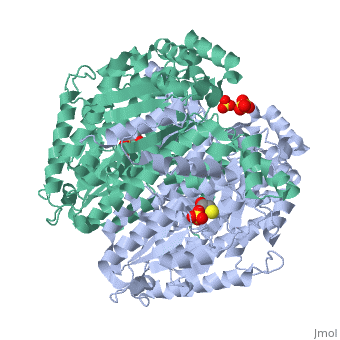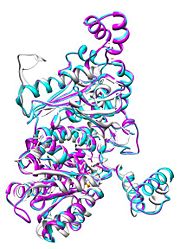Sandbox bcce04
From Proteopedia
| Line 23: | Line 23: | ||
__NOTOC__ | __NOTOC__ | ||
=='''Mechanism'''== | =='''Mechanism'''== | ||
| - | The proposed reaction mechanism of PGI for the reversible conversion of glucose-6-phosphate to fructose 6-phosphate involves an acid/base catalysis by the enzyme. The basic mechanism involves the isomerization of an aldose to a ketose. This is performed by a ring opening, followed by an isomeration of the opened ring, then a ring closing. A detailed step by step mechanism of this process can be seen as follows <ref> Voet D, Voet J, and Pratt C. Fundamentals of Biochemistry Life at the Molecular Level. New York: John Wiley & Sons, 2008. Print.</ref>: | ||
| - | |||
| - | '''Step 1.''' The substrate binds to the enzyme. | ||
| - | |||
| - | '''Step 2.''' The residue Lys518 (or His388b) acts as an enzymatic acid catalyzing the opening of the ring. | ||
| - | |||
| - | '''Step 3.''' Conserved Glu357 abstracts the acidic proton from C2 forming a cis-enendiol intermediate. | ||
| - | |||
| - | '''Step 4.''' Glu357 donates back the proton at the C1 position. | ||
| - | |||
| - | '''Step 5.''' Lys518 (or His388b) abstracts back the proton from the sugar ring oxygen, resulting in a ring closure, to give the product. | ||
| - | |||
| - | [[Image:Mech.png]] | ||
=='''Regulation and Inhibition'''== | =='''Regulation and Inhibition'''== | ||
| - | '''Regulation''' of phosphoglucoisomerase is only done by the relative concentrations of glucose-6-phosphate and fructose 6-phosphate, towards equilibrium. Nevertheless, it was found that the kinetic parameters of PGI does depend on the pH and temperature of the environment. | ||
| - | The following kinetic parameters are proposed for rabbit PGI at pH 8.5 and 30°C <ref>PMID: 5647261</ref> | ||
| - | |||
| - | |||
| - | [[Image:Kinetic_PGI.JPG]] | ||
| - | |||
| - | |||
| - | It is interesting to point the regulation of PGI in other aspects that are not involved in metabolism. For example, PGI acts as a "cytokine" outside the cell in that it can be used as a cell signalling protein. PGI has been found to to be associated with AMF cells, which is found to regulate tumor cell motility. Regulation of these extracellular "cytokine" PGI/AMF can be seen. The amount of PGI/AMF that is secreted inside and outside the cell based on infection <ref> Funasaka T, Hu H, Yanagawa T, Hogan V, Raz A. Down-Regulation of Phosphoglucose Isomerase/Autocrine Motility Factors Results in Mesenchymal-to-Epithelial Transition of Human Lung Fibrosarcoma Cells. (2007) Cancer Res, 76(9) </ref>. | ||
| - | |||
| - | |||
| - | '''Inhibition''' of the phosphoglucoisomerase regulated reaction of glucose-6-phosphate to fructose-6-phosphate can also occur. Competitive competition can take place from inhibitors such as 5PAH. 5PAH resembles PGI, differing only in a nitrogen atom at the first carbon position. 5PAH is reported to have a Ki of .0000002 M <ref> Arsenieva D, Hardre R, Salmon L, Jeffery CJ. The crystal structure of rabbit phosphoglucose isomerase complex with 5-phospho-D-arabinonohydroxamic acid. (2002),PNAS, 99(9) </ref>. | ||
| - | =='''Links'''== | ||
| - | |||
| - | |||
| - | * Crystal Structure of human phosphoglucose isomerase (PDB=[[1iat]]) | ||
| - | |||
| - | * Crystal Structure of rabbit phosphoglucose isomerase complexed fructose 6-phosphate (PDB=[[1hox]]<ref>PMID:11425306</ref>) | ||
| - | |||
| - | * Other available structures [[1dqr]], [[1g98]], [[1gzd]], [[1gzv]], [[1hm5]], [[1iri]], [[1jiq]], [[1jlh]], [[1koj]], [[1n8t]], [[1nuh]], [[1xtb]]. | ||
==3D structures of phosphoglucose isomerase== | ==3D structures of phosphoglucose isomerase== | ||
Revision as of 14:27, 6 August 2014
Imaginary Protein
| |||||||||||
Mechanism
Regulation and Inhibition
3D structures of phosphoglucose isomerase
PGI
2pgi, 1b0z – GsPGI – Geobacillus stearothermophilus
1dqr, 1hm5, 1n8t – rPGI – rabbit
1iat, 1jlh – hPGI – human
1qxj, 1x8e, 3sxw – PfPGI – Pyrococcus furiosus
1j3p, 1j3q – TlPGI – Thermococcus litoralis
1q50 – LmPGI – Leishmania Mexicana
1u0e, 2cvp – mPGI – mouse
2q8n – PGI – Thermotoga maritima
3hjb – PGI – Vibrio cholera
3ifs – PGI – Bacillus anthracis
2wu8 – PGI – Mycobacterium tuberculosis
3ljk – FtPGI (mutant) – Francisella tularensis
3nbu – PGI – Escherichia coli
PGI complex with fructose-6-phosphate
1hox – rPGI + fructose-6-phosphate
1t10 - LmPGI + fructose-6-phosphate
2gc2 - PfPGI + fructose-6-phosphate
2cxs, 2cxt - mPGI + fructose-6-phosphate
3m5p - FtPGI (mutant) + fructose-6-phosphate
PGI complex with sorbitol-6-phosphate
1xtb - rPGI + sorbitol-6-phosphate
2gc1 - PfPGI + sorbitol-6-phosphate
2cxq - mPGI + sorbitol-6-phosphate
PGI complex with phosphoarabinose
1gzd, 1gzv – PGI + phosphoarabinose – pig
1c7r - GsPGI + phosphoarabinose
2cxp – mPGI + phosphoarabinose
1nuh - hPGI + phosphoarabinose
1qsr, 1x7n, 1x82 - PfPGI + phosphoarabinose
2gc0 - PfPGI + phosphoarabinose derivative
1koj – rPGI + phosphoarabinose derivative
PGI complex with gluconate-6-phosphate
1qy4 - PfPGI + gluconate-6-phosphate
1j3r - TlPGI + gluconate-6-phosphate
2cxr - mPGI + gluconate-6-phosphate
3q7i - FtPGI (mutant) + gluconate-6-phosphate
PGI complex with glucose-6-phosphate
1u0f - mPGI + glucose-6-phosphate
3ff1 - PGI + glucose-6-phosphate – Staphylococcus aureus
2o2c - TbPGI + glucose-6-phosphate – Trypanosoma brucei
Other PGI binary complexes
2o2d – TbPGI + citrate
1u0g, 2cxo - mPGI + erythrose-4-phosphate
3q88 – FtPGI (mutant) + ribose bisphosphate
1c7q – GsPGI + phosphate inhibitor
2cxn, 2cxu – mPGI + phosphate
1g98 – rPGI + transition state analog
2gc3 - PfPGI + mannose-6-phosphate
Additional Resources
For additional information, see: Carbohydrate Metabolism


